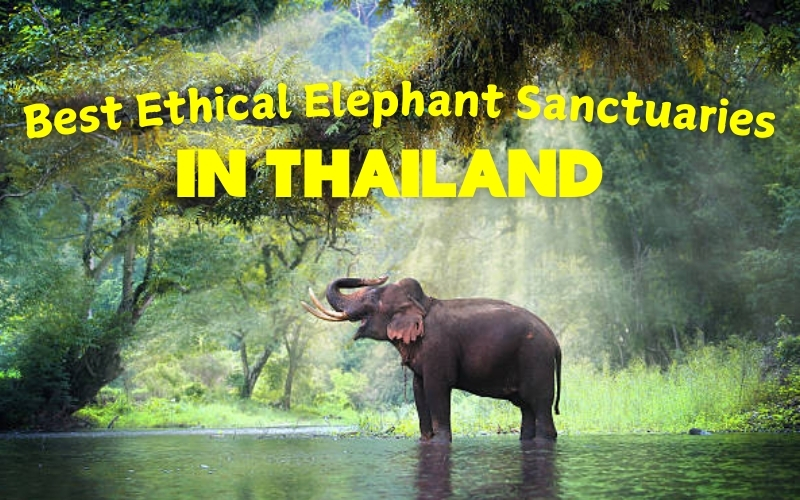
Thailand is famous for its elephants, but not all experiences are kind to them. For many years, many elephants were used for logging, riding, and performing. Today, more and more ethical sanctuaries are offering a better way – a safe haven where elephants are rescued, cared for, and free to roam the wild. In this guide, you’ll learn what makes a truly ethical sanctuary, the history of elephant tourism in Thailand, and the best ethical elephant sanctuaries in Thailand to visit for a responsible encounter with these gentle giants.
What is an Ethical Elephant Sanctuary?
When I first heard the phrase “ethical elephant sanctuary” in Thailand, I wasn’t sure what it actually meant. Many places call themselves sanctuaries, but not all of them put the welfare of elephants first. After visiting a few around the country, I realized the difference lies in how the elephants are treated and how visitors are allowed to interact with them.
There is a lot of debate about what constitutes an “ethical” elephant sanctuary. Simply put, an ethical elephant sanctuary puts the needs of the elephants above profits. Ethical sanctuaries (mostly) allow elephants to roam freely on their premises, which can be hundreds of hectares, allowing them to have a fairly large territory. They are a safe haven for elephants rescued from forced labor, logging, circuses, or exploitative elephant riding camps. Here, elephants are kept in a natural environment, with plenty of room to roam, socialize, and be their true selves.
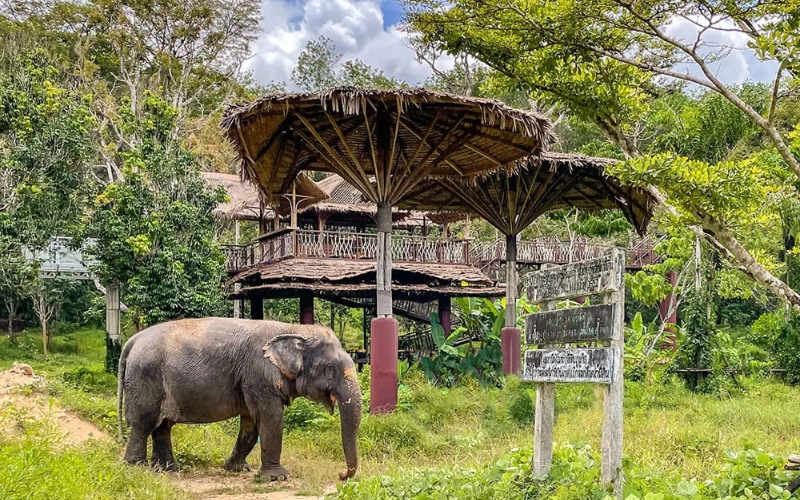
Elephants in a natural habitat
Some sanctuaries allow visitors to feed and bathe the elephants. This is controversial, with some feeling that it takes away the elephants’ autonomy. After all, if elephants were in the wild, they wouldn’t be bathed by groups of tourists multiple times a day. Some sanctuaries even encourage visitors to stand back and just watch from a distance, so as not to upset the elephants too much. For visitors, this means the experience is very different from the “entertainment” many of us were used to as children. Instead of climbing on the backs of elephants, you can spend time walking with them through the jungle, feeding them fresh fruit, or watching them bathe in rivers or muddy ponds.
The History of Elephant Tourism in Thailand
When you travel through Thailand, you cannot help but notice how deeply the elephant is embedded in the country’s identity. Not only are elephants majestic, they are even symbols of royal power. In fact, white elephants are still considered sacred and a symbol of prosperity in Thai culture.
But did you know that in the past, when machines were not yet developed, elephants were used in the logging and agricultural industries. They were also used as means of transportation in everyday life and even as weapons of war. But everything changed in 1989, when the Thai government banned commercial logging to protect the forests. Overnight, thousands of elephants and their mahouts (caretakers) were left jobless. With no forests to exploit and no income, many turned to the only industry that could make a profit, tourism.
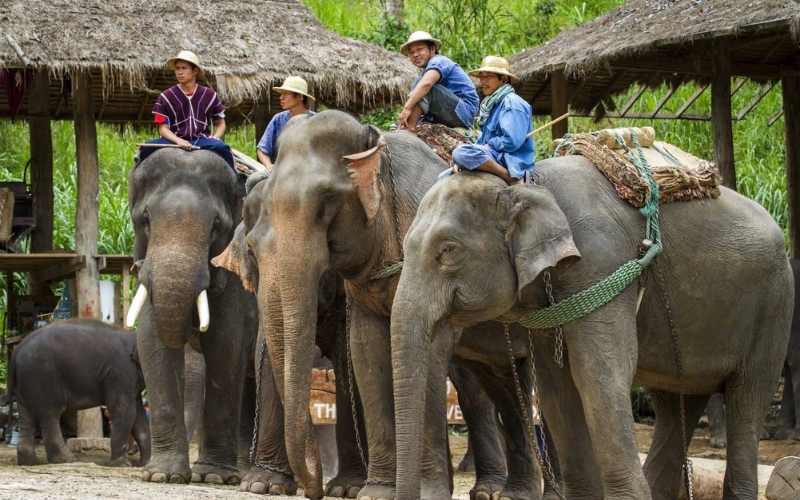
Elephant rides became a major part of Thailand’s tourism industry in the late 20th century
During the 1990s, tourism to Thailand increased rapidly and Thais began to realise that elephants were a major tourist attraction. Foreign tourists wanted to ride elephants, as well as touch and bathe with them, and were willing to pay a lot of money to do so. This was also when elephant camps began to spring up all over Thailand. Initially, they offered elephant rides through the jungle or elephant shows where elephants performed tricks. I remember hearing stories from mahouts who said they had no choice, it was the only way to support their elephants and their own families.
Sadly, what seemed like “fun” to tourists often meant long hours of work, poor treatment and harsh training for the elephants. Over time, awareness began to grow and demand changed. Today, there is a growing trend towards ethical elephant tourism – where elephants are not forced to perform but are allowed to live more naturally. At most of these sanctuaries you will find former working elephants, rescued from the trekking or logging industry.
How To Find An Ethical Thailand Elephant Sanctuary In Thailand?
Some factors to consider
When I first started planning my trip to see elephants in Thailand, I was admittedly overwhelmed. Everywhere I looked, I saw elephant camps advertising elephant rides, circus acts, or photo ops with baby elephants. While it seemed fun at first, the more I looked, the more I realized how harmful these activities were to the animals. To help you choose an ethical elephant sanctuary, we recommend considering the following key points:
- No-riding policy: Ethical sanctuaries do not offer elephant rides. Riding elephants can cause long-term damage to an elephant’s spine and overall health, and this often indicates a place that puts profit over animal welfare.
- Transparent operations: Look for sanctuaries that are open about their operations. They should be willing to discuss how they care for their elephants and what they do to ensure their well-being.
- Elephant behavior: In ethical sanctuaries, elephants should be able to express their natural behaviors. This includes roaming freely, interacting with other elephants, foraging for food and bathing in water sources.
- Educational focus: A focus on visitor education is a hallmark of an ethical sanctuary. These facilities should provide information about elephant conservation and the impact of human activity on the animals’ lives.
- Responsible volunteering: If a sanctuary offers a volunteer program, it should be designed in a responsible manner. Volunteers should have tasks that genuinely contribute to the welfare of elephants and the operation of the sanctuary.
- Ample space: Elephants need ample space. Ethical sanctuaries have ample land so that elephants can move freely and express their natural behaviors without being confined.
- Veterinary Care: Regular and professional veterinary care is required, with dedicated staff to meet the health needs of elephants.
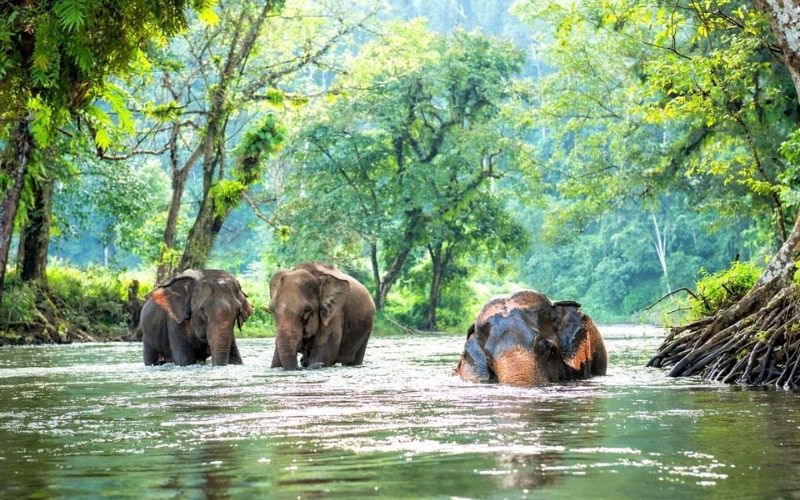
Ethical sanctuaries allow elephants to bathe and play naturally, without forced activities
Some reliable resources
There are a number of organizations and websites that provide recommendations and certifications for ethical elephant sanctuaries in Thailand. These can be valuable resources for travelers who want to ensure their trip supports responsible wildlife tourism.
- World Animal Protection: An international animal welfare nonprofit that regularly lists and certifies ethical elephant sanctuaries that meet their strict animal welfare criteria.
- Save Elephant Foundation: A Thai nonprofit dedicated to providing care and support for Thailand’s captive elephant population through a multifaceted approach, including rescue and rehabilitation programs, advocacy, and education. Their website features ethical sanctuaries like Elephant Nature Park.
- Global Federation of Animal Sanctuaries (GFAS): A global organization that certifies animal sanctuaries based on strict standards of care. GFAS-accredited sanctuaries are often a safe option for ethical activities.
- Lonely Planet and TripAdvisor: These popular travel resources sometimes have articles and lists of recommended ethical elephant tourism experiences, based on traveler reviews and responsible travel guidelines.
- Elephant Rescue and Survival Asia (EARS Asia): They work to improve the welfare of elephants in Asia and provide a list of ethical tourism destinations.
> > > If you’re planning to combine your sanctuary visit with a broader journey across the country, our carefully designed Thailand tours will help you experience the best of culture, nature, and authentic encounters, all without the stress of planning on your own.
Best ethical elephant sanctuaries in Thailand
Burm and Emily’s Elephant Sanctuary (BEES)
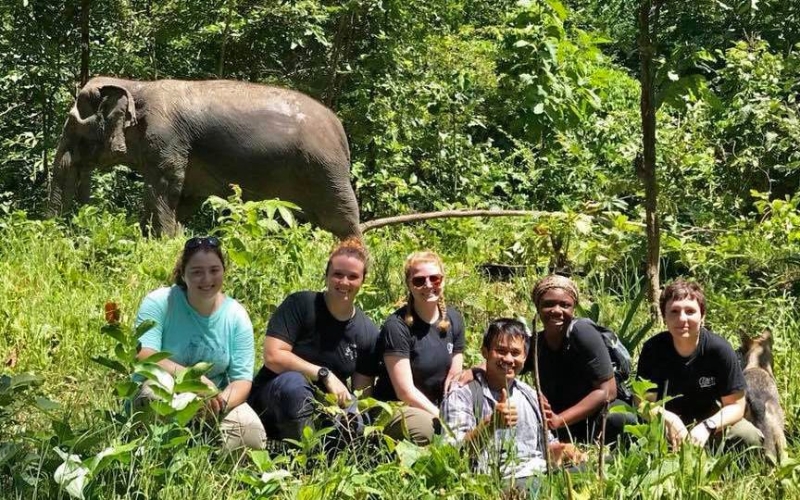
Visitors at BEES learn about elephant welfare through observation, not riding
Address: 34 Tambon Chang Keung, Mae Chaem District, Chiang Mai
Opening hours: 8:00AM to 4:00PM, typically on Tuesdays and Saturdays
The Burm and Emily Elephant Sanctuary (BEES) is a sanctuary for elderly, injured or retired elephants who have spent years logging or hiking for tourism. The sanctuary is located in a valley surrounded by lush greenery and majestic mountains, about a two-hour drive south of Chiang Mai. What struck me during my visit was how the elephants – rescued from elephant camps or logging jobs – are given a real chance to heal and be themselves. They roam the forest, forage for food, bathe in streams and sleep in secure enclosures at night.
You can volunteer here, scheduled on certain days. Under the no-interference policy, you will assist with seasonal work but will not have direct contact with the elephants. Main activities range from preparing afternoon fruit snacks, cutting grass and corn for the elephants, cleaning their areas and helping to care for other animals at BEES.
Visitors are encouraged to observe from a respectful distance, without touching or pressuring them to interact. During the tour, we follow the elephants wandering the jungle trails – Mae Kam and Mae Dok bathing in the river pools, while the elderly ThongDee forages gently nearby. Our guides tell them the story of their rescue while we prepare fresh produce for them. The simple act of chopping bananas or sugar cane for ThongDee is more meaningful than any stream bath or selfie.
Elephant Nature Park
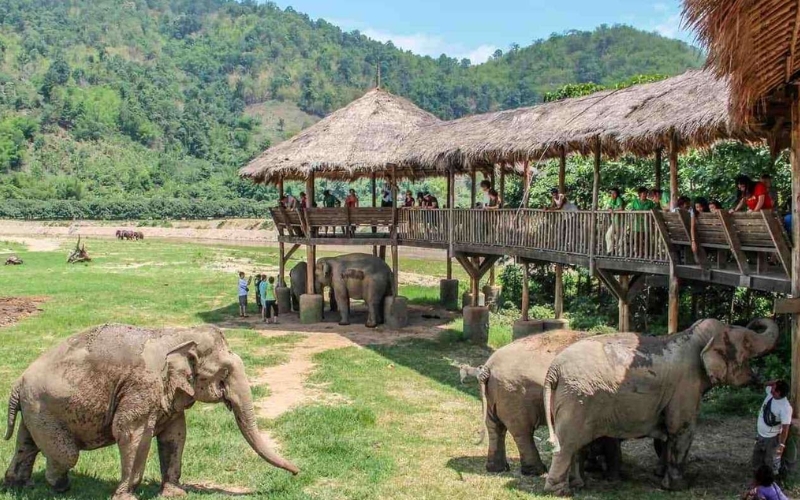
Travelers observing elephants respectfully at Elephant Nature Park
Address: 1 Ratmakka Road, Phra Sing, Chiang Mai, Thailand
Opening hours: Open daily, 7 AM –5 PM
Elephant Nature Park is one of Thailand’s most famous elephant conservation projects. Located in Chiang Mai, Elephant Nature Park is considered a pioneer in ethical elephant tourism and has received numerous awards for its elephant conservation and animal welfare efforts, making it a safe choice for newcomers and families. Over 75 elephants roam freely here, and each has a heartbreaking story: many have been rescued from torture camps, exploitation for tourism, logging, or other abusive purposes.
During your visit, you can participate in a range of activities including preparing and feeding elephants, walking with elephants, and observing them in their natural habitat. You can also learn about the history and rehabilitation of elephants, as well as the challenges facing elephant conservation in Thailand. I joined the half-day morning program, which started with a gentle walk through the forest to meet the elephants, watching them bathe, feed, and even relax in the mud pits by the river.
Friends of the Asian Elephant Hospital
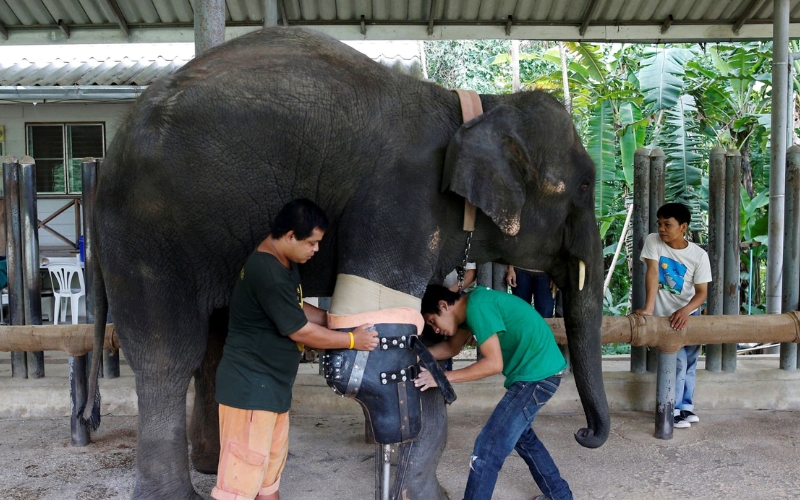
Dedicated staff and caretakers supporting elephant rehabilitation
Address: 295 Moo 6, Lampang–Chiang Mai Road, Viengtan, Hangchat District, Lampang, Thailand.
Opening hours: 8:30 AM – 4:30 PM
One of the only elephant hospitals in the world, the Friends of the Asian Elephant (FAE) Hospital is a unique elephant experience in Thailand. The center specializes in treating and rehabilitating sick elephants right here in Lampang, while the hospital’s mobile veterinary clinic treats sick, weak, and injured elephants from all over Thailand.
What really sets FAE apart is their dedication to healing – not just physically, but mentally as well. Elephants come here with serious injuries, often from landmines or accidents. Visitors are welcome at the hospital, and here you can learn about how these professionals care for and treat injured and disabled elephants. Seeing vulnerable elephants treated is a far cry from seeing small, domesticated animals treated, making this a fascinating stop. Two elephants, Mosha and Motala, tragically lost limbs and were fitted with prosthetics made right here, and were even filmed to convey the suffering, pain and protection messages behind them.
Phuket Elephant Sanctuary
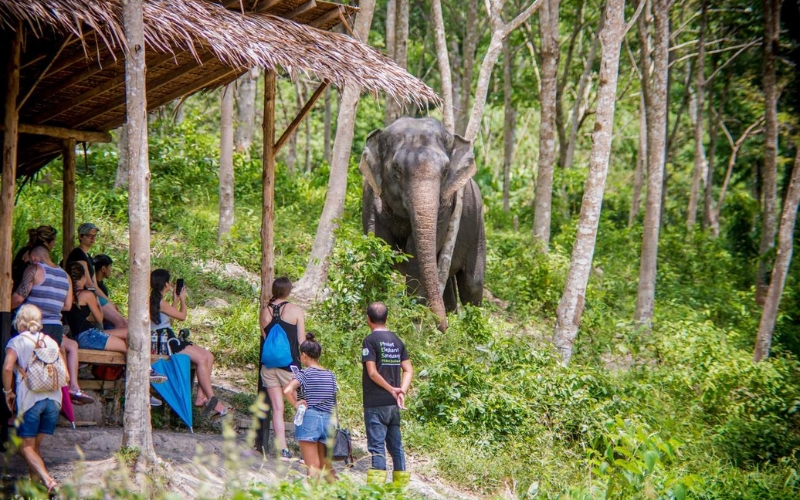
Travelers quietly observing elephants in their natural environment
Address: 100, Moo 2, Paklok, Phuket, Thailand
Opening hours: 9 AM – 5 PM
One of the most meaningful experiences I had in Thailand was spending a morning at the Phuket Elephant Sanctuary, the island’s first humane sanctuary for rescued elephants. Nestled in 30 acres of lush tropical forest next to Khao Prae Teao National Park, the sanctuary offers a peaceful, no-riding, no-show environment where elephants can live in their most natural setting. Plus, it’s located on Phuket Island, making it a convenient destination for those planning a Thailand trip that includes both beaches and wildlife experiences.
The sanctuary is leading the way in the treatment and rehabilitation of retired and rescued elephants in southern Thailand. The highlight of this elephant sanctuary is the canopy walk, where you can stroll along the longest walkway in Thailand while watching elephants roam and feed in the jungle below. You can also watch them roam freely on the lush green grasslands, splash in the water or enjoy a therapeutic mud bath, taking you through different aspects of elephant life in their natural habitat.
> > > If you’re dreaming of a journey that combines Thailand’s cultural treasures, natural wonders, and time to connect with elephants in a responsible way, our Best of Thailand: Bangkok, Chiang Mai and Phuket in 10 Days tour is a perfect choice to experience it all.
Samui Elephant Sanctuary
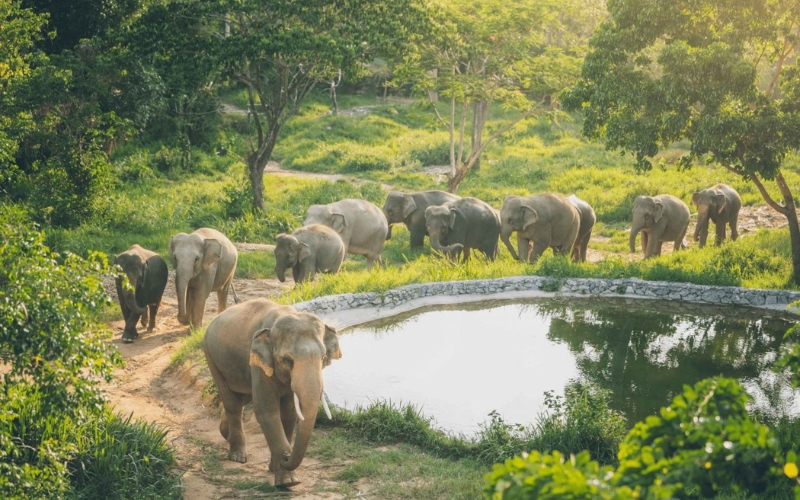
Rescued elephants roaming peacefully, they are free from riding and performances
Address: Maret, Koh Samui, Surat Thani, Thailand
Opening hours: 8 AM – 5 PM
This 10-acre Elephant Sanctuary Samui is home to dozens of rescued elephants. One of the first humane sanctuaries on Koh Samui, it provides a safe haven for elephants who were previously overworked or mistreated in logging and tourism camps. Inspired and supported by the world-famous Elephant Nature Park in Chiang Mai, the Elephant Sanctuary Samui is the perfect place to see well-treated and happy elephants in their natural habitat. Visitors are only allowed to walk alongside and observe the elephants as they feed, socialize, and play in their specially constructed pools and mud pits.
Boon Lott Elephant Sanctuary (BLES)
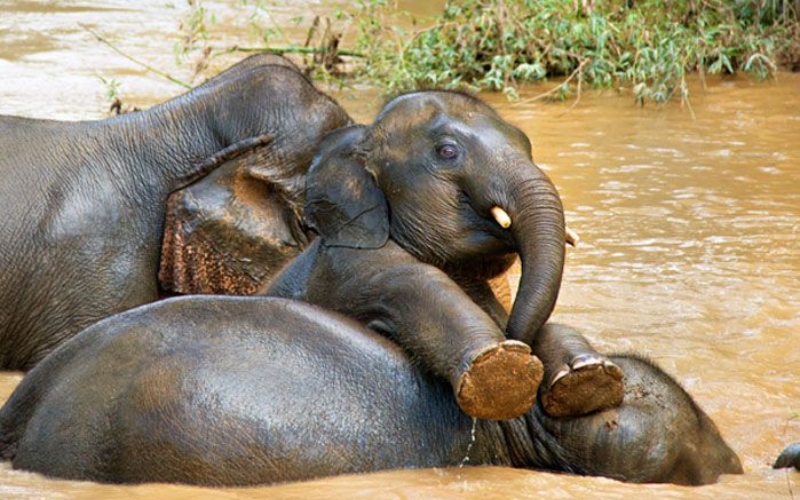
Boon Lott Elephant Sanctuary in Thailand
Address: Ban Tuek, Si Satchanalai District, Sukhothai, Thailand
Named after a rescued baby elephant, Boon Lott, BLES is located in Sukhothai, an ethical elephant sanctuary that provides a home for elephants rescued from abuse or exploitation. The sanctuary is set in a peaceful and secluded natural environment, with rescued elephants roaming freely across 600 acres of forested land with banana plantations, grasslands, freshwater rivers and open fields.
With only three guest houses, visitor numbers are deliberately kept low to ensure the health and quality of life of the small herd of rescued elephants that live here. Only 10 guests per stay ensures a relaxed, stress-free atmosphere for both guests and elephants. You will not ride the elephants, bathe them or treat them like props. Instead, it’s an immersive, hands-off experience – watch them rediscover natural behaviors like grazing, dust bathing and trekking through the forest. If you want to stay longer, BLES also offers a three-month volunteer programs where you can work with experienced mahouts, assisting with the care and rehabilitation of the elephants.
Elephant Hills
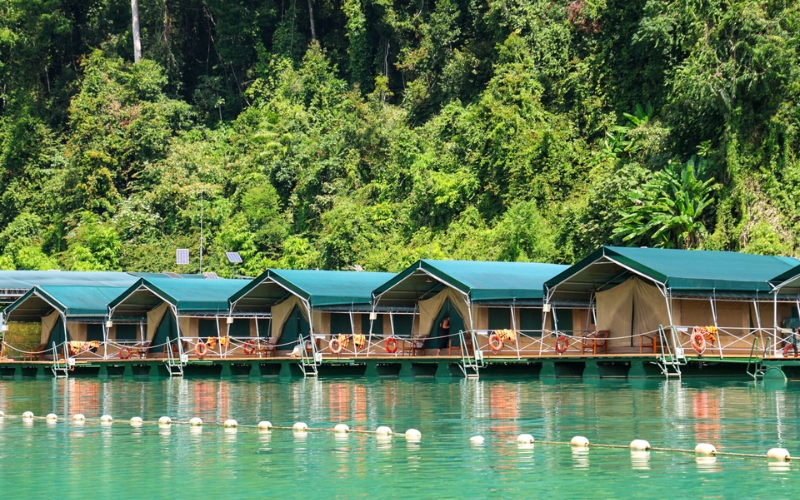
Eco-luxury tented camp at Elephant Hills in Khao Sok
Address: 316 Moo 7, Klong Sok, Panom, Surat Thani, Thailand
Elephant Hills is Thailand’s first luxury tented camp, combining the glamour of a safari with the pristine beauty of the Thai rainforest. What makes Elephant Hills even more special is the opportunity to stay in one of the resort’s two luxury camps, allowing you to completely immerse yourself in nature.
This is Thailand’s first luxury tented camp, combining the glamour of a safari with the pristine beauty of the Thai rainforest. You can feel the difference from the moment you arrive, the staff greet you with warm smiles and eco-friendly gifts, and you know you’re stepping into something special. Take time to kayak, visit local markets, hike through mangroves and of course, see and learn about elephants in an ethical and responsible way.
Elephant Haven Thailand
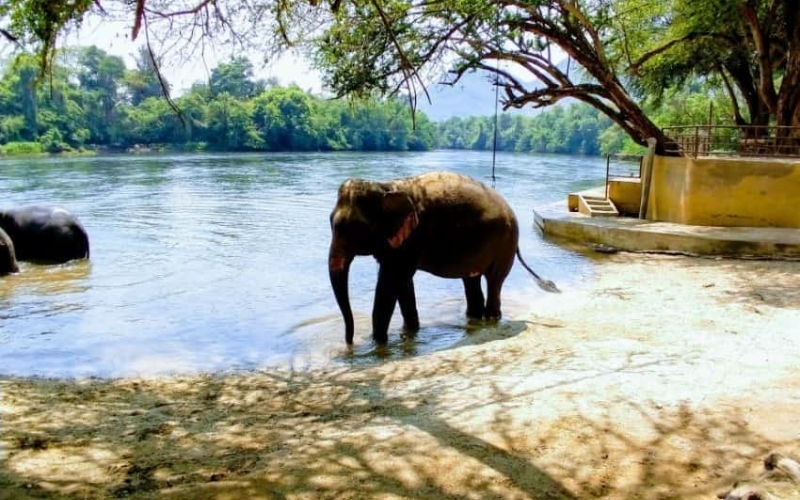
A peaceful moment as elephants cool off by the river
Address: Tambon Lum Sum, Sai Yok District, Kanchanaburi
Opening hours: 9:00am – 3:00pm daily
Elephant Haven Thailand is located in Kanchanaburi Province, Thailand, about a 3-hour drive from Bangkok. Also known as Sai Yoke Elephant Camp, the sanctuary is set in a dense forest area, providing a peaceful and natural habitat. As the name suggests, the sanctuary aims to provide a safe haven for elephants and encourages people to remove their saddles so they no longer have to perform.
The sanctuary currently offers day trips, overnight stays and week-long volunteer opportunities. You can follow some of your fellow elephants for a leisurely stroll through the lush forest, or head to the kitchen to enjoy their special afternoon tea of fresh fruit, rice and millet.
The sanctuary’s mission is evident, not only in the way the elephants are treated, but also in the way they share their knowledge. The guides are passionate and respectful, explaining each elephant’s story and how they were treated. This makes the experience both touching and rewarding.
Wildlife Friends Foundation Thailand
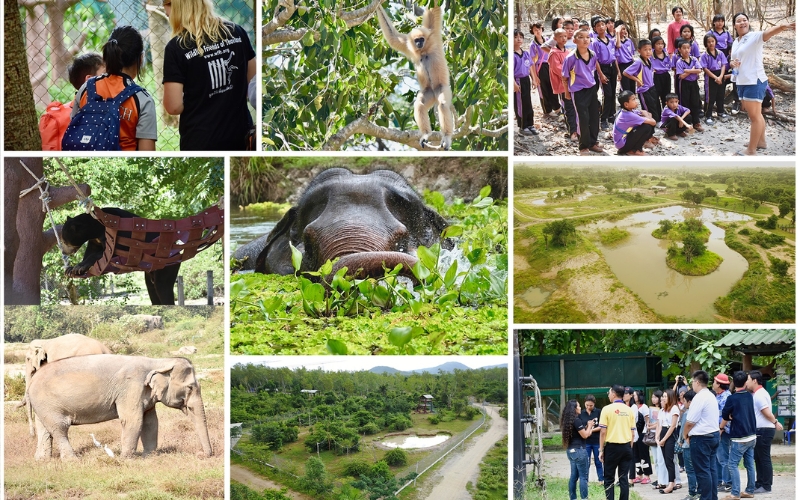
Visitors learning about elephant care at Wildlife Friends Foundation
Address: 108 Moo 6, Tambon Tha Mai Ruak, Amphoe Tha Yang, Phetchaburi, Thailand
Opening hours: 9:00 AM to 5:00 PM daily
Wildlife Friends Foundation Thailand (WFFT) is an animal rescue and rehabilitation center that provides a safe and nurturing environment for not only elephants but also many other animals, including big cats, bears, primates, and deer. You will feel the difference immediately: this is not a zoo; it is a sanctuary where animals heal and thrive. This wildlife sanctuary and hospital rescues, rehabilitates, and shelters all animals from abuse. Most of the 600+ animals have been rescued from harsh conditions or abandoned after becoming unwanted pets.
The sanctuary offers full or half-day tours of the elephant sanctuary and wildlife rescue center. As an Elephant Sanctuary volunteer, you will help prepare food for the elephants, clean their enclosures, and assist with various other maintenance tasks around the center. I signed up for their full day experience and it was one of the most meaningful days of my trip to Thailand. At 10:00am, I joined a small group and learned not only about the animals but also about the people who save them. We toured the rescue center, the elephant sanctuary and even the tiger area. The stories of trauma, recovery and resilience were unforgettable.
Some useful tips
Before you book your tickets, there are a few things to keep in mind to get the most out of your experience at elephant sanctuaries in Thailand. From what to pack and how to behave around elephants to practical details like transportation and opening hours, here are some tips I’ve learned from experience to help you enjoy your visit responsibly and comfortably.
- Book early: These sanctuaries almost always limit the number of visitors, even during the day. I once missed BLES because of the long queues. So book early when you’re planning your trip to Thailand to secure your spot.
- Choose when to go: The best time to visit is during the dry season from November to February, when the weather is cooler and drier, and it’s easier to navigate the jungle. If you’re going in the hotter months, opt for a morning tour.
- Choose the right sanctuary for you: There are quite a few elephant sanctuaries in Thailand, and of course you can’t visit them all in one trip, so choose the one that fits your desired experience. If you’re short on time, the Elephant Nature Park near Chiang Mai is a great option. On the other hand, if you’re looking for a more relaxing and slower-paced experience, choose BLES.
- Respect the sanctuary rules and guidelines: Most sanctuaries have similar rules to protect elephants and their habitats. The biggest thing they have in common is that you can’t interact directly or force the elephants, and many just ask you to observe them from a distance. Follow these rules so that the elephants can live in their most natural environment, and who knows, they might give you a glimpse of their true behavior.
- Hire a guide: If possible, I recommend taking a guided tour or choosing a program with a staff member to talk to. When I visited the Elephant Nature Park, hearing each elephant’s personal rescue story made the experience so much more meaningful. A guide can turn what might seem like “just elephants walking” into an unforgettable lesson in resilience, care, and conservation.
- Dress appropriately: Be practical as you’ll be walking through dense forest, crossing small streams, or muddy swamps. So bring dark, lightweight clothing, waterproof shoes, and especially bug spray (there are quite a few mosquitoes) to make the trip more comfortable.
- Support sanctuaries responsibly: Remember that these sanctuaries rely heavily on the support of visitors. Paying an entrance fee is helpful, but if you want to contribute more, consider donating, buying local products, or simply sharing information about their activities. Even small donations go directly to providing food, medical care, and improving the elephants’ habitat.
- Getting to the sanctuaries: Don’t rely on taxis or ride-hailing apps, as most elephant sanctuaries in Thailand are quite far from the city center, and even if you can get there, getting back is difficult. Your best bet is to book a sanctuary program that includes transportation, or ask your hotel to arrange a private car in advance.
This list highlights some of the best ethical elephant sanctuaries in Thailand, where you can connect with these gentle giants in a way that respects their freedom and well-being. Each sanctuary offers something unique, but they all share a common mission: to give elephants a better life. If you’re planning a trip to Thailand and want to have a memorable elephant experience, we’d love to help. Contact us today and let’s plan a meaningful and memorable adventure in Thailand.
Read more:
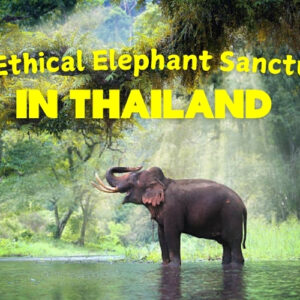
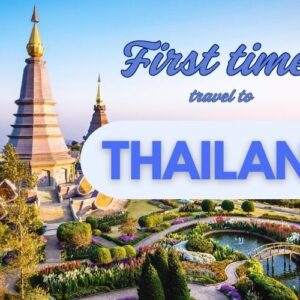

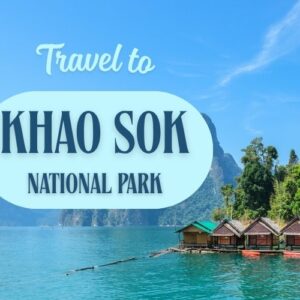
I’m curious. Can visitors actually touch or feed the elephants at most of these sanctuaries, or is it better to just watch them from a distance?
Most ethical sanctuaries prefer that visitors observe from afar so the elephants can behave naturally. Some may allow limited feeding, but only under supervision and never forced.
I’d love to know roughly how much a typical day-visit package costs (including transport) at one of the ethical sanctuaries you mention?
While exact prices vary by sanctuary, a typical day-visit package at a reputable ethical elephant sanctuary in Thailand (including round-trip transport from a nearby city, lunch, sanctuary fees and a guided session) might range from around US$80-150 per person. Some premium options or full-day programmes may go higher. I deliberately didn’t list specific current pricing in the article because they change often.